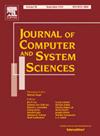诱导树木覆盖和广义Yutsis性质
IF 0.9
3区 计算机科学
Q1 BUSINESS, FINANCE
引用次数: 0
摘要
图G的Yutsis性质是将其顶点集划分为两个诱导树的性质。尽管在平面图上识别Yutsis图是np完全的,但仍然可以考虑两个更具挑战性的问题:(i)识别k-Yutsis图,k-Yutsis图是顶点集划分为k个诱导树的图,k≥2是固定的;(ii)确定给定图G的树覆盖数,即覆盖G的所有顶点的顶点不相交诱导树的最小个数。我们证明了与k-Yutsis弦图的多项式时间识别相比,确定分割图G的树覆盖数是np困难的。我们还研究了基于树宽和团宽参数化的树盖数计算和k-Yutsis图识别。本文章由计算机程序翻译,如有差异,请以英文原文为准。
Induced tree covering and the generalized Yutsis property
The Yutsis property of a graph G is the property of partitioning its vertex set into two induced trees. Although recognizing Yutsis graphs is NP-complete even on planar graphs, it is still possible to consider two even more challenging problems: (i) recognizing k-Yutsis graphs, which are graphs that have their vertex sets partitioned into k induced trees, for a fixed ; (ii) determining the tree cover number of a given graph G, i.e., the minimum number of vertex-disjoint induced trees covering all vertices of G. We prove that determining the tree cover number of a split graph G is NP-hard, contrasting with the polynomial-time recognition of k-Yutsis chordal graphs. We also investigate the tree cover number computation and the k-Yutsis graph recognition concerning treewidth and clique-width parameterizations.
求助全文
通过发布文献求助,成功后即可免费获取论文全文。
去求助
来源期刊

Journal of Computer and System Sciences
工程技术-计算机:理论方法
CiteScore
3.70
自引率
0.00%
发文量
58
审稿时长
68 days
期刊介绍:
The Journal of Computer and System Sciences publishes original research papers in computer science and related subjects in system science, with attention to the relevant mathematical theory. Applications-oriented papers may also be accepted and they are expected to contain deep analytic evaluation of the proposed solutions.
Research areas include traditional subjects such as:
• Theory of algorithms and computability
• Formal languages
• Automata theory
Contemporary subjects such as:
• Complexity theory
• Algorithmic Complexity
• Parallel & distributed computing
• Computer networks
• Neural networks
• Computational learning theory
• Database theory & practice
• Computer modeling of complex systems
• Security and Privacy.
 求助内容:
求助内容: 应助结果提醒方式:
应助结果提醒方式:


